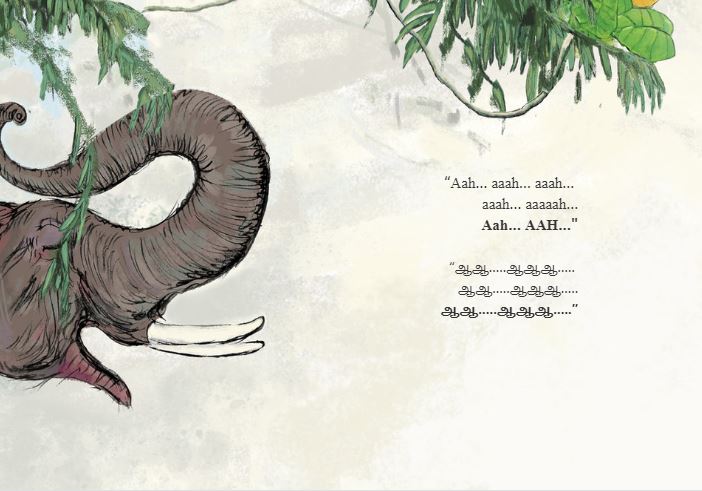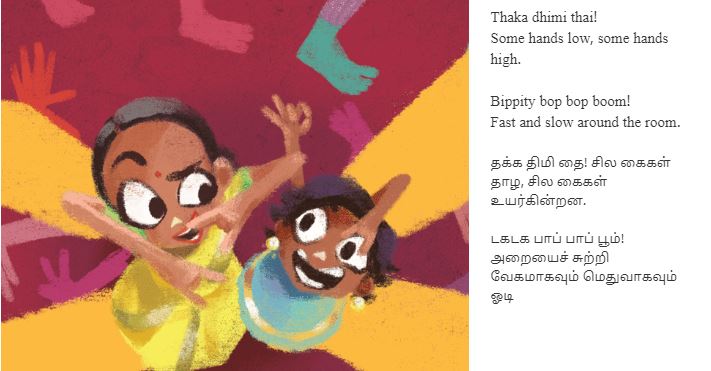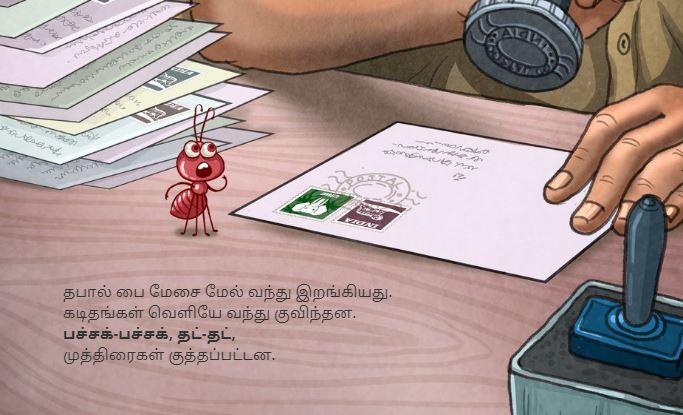What did the elephant say in Tamil?

by Vetri
The Merriam-Webster dictionary defines Onomatopoeia as:
1: the naming of a thing or action by a vocal imitation of the sound associated with it (such as buzz, hiss)
2: the use of words whose sound suggests the sense
Whenever we translate, we don’t think about how to transfer words, but the meaning. How we reproduce sentences in our language that mean the same. Making it read like as if it was written originally in our language is an important aspect of translating early reading stories.
Sounds play an important role in many early reading stories, and indeed our stories too. A challenge we face is how to translate the words that mark sounds and not meaning per se? Though an English Crow and Tamil Crow might make the same sounds. Can we write them similarly? These ‘words’ contain sound and meaning, both of which have to be recreated in a similar way. Almost always, there is an image, where a certain character or event is making the sound. We work towards creating a matching sound to that, more than how it is written in the source language.
We decided to take a look, how all of our wonderful Tamil translators have handled this in the last year. In English there are dictionaries for Onomatopoeia which describe how certain words are used to represent certain sounds. Though Tamil storytelling is rich, we don’t have such defined sets. As storytelling and translation are equally creative and fluid, having defined dictionaries alone won’t help us much either. But some of us use a transliterated version of the English sound word that we are translating. Some of them work and some of them don’t.
There were a wide variety of sounds in our recent stories. Animals, Humans, Robots, Machines, Wind, Ghosts and all kinds of characters that make noises! We did a few books focused on sounds as well. While some of them were easy to handle, from the perspective of a translation editor, Some were not. Here’s a sample of how we handled a few challenges.
Here’s how in Are you an insect? The very common expression of being shocked by an insect worked in English and Tamil:
While eek is a common enough expression in English, ayyee was the Tamil equivalent. Even for a bilingual reader, reading ஈஈஈஈஈக்க்க்க் won’t give the same sense as reading Eeeeekkkk, and vice versa!
EEEEEEEEEEEEEEEEEEEEKKK! -அய்ய்ய்ய்ய்ய்ய்ய்ய்ய்யய்ய்யேஏஏஏஏஏஏஏஏ
Do read how T.Sundari laughed in different ways in The Girl who couldn’t stop laughing.
In Achoo! sneezing and the about-to-sneeze sounds -even if it involved an elephant- were quite the same in English and Tamil.

Though Thakka dhimi thai was the same in Tamil. Bippity bop bop boom had to become dakadaka bop bop boom! For it to match the enthusiastic Gappu

When Peepre looked at the postmasters go Thakata-tham, thuddata-thud putting seals in English. In Tamil, we added an extra sound of the seals being dipped in ink!

We had more exciting experiences with sounds as well. But these broadly portray how we handled them. Hoping to learn alternative perspectives on translating these, and also hoping that these will be helpful to translators facing similar situations.
Vetri is an Assistant Editor for Tamil at Pratham Books and a writer-translator, who often feels like he is banished to live between English and Tamil for eternity.
